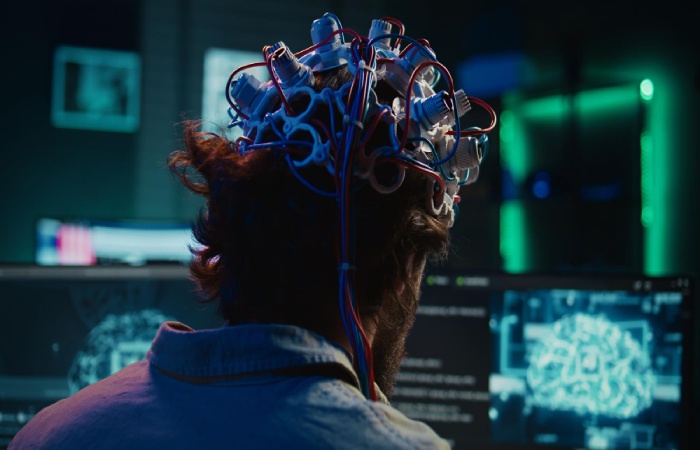We’ve stopped accepting our biology as fixed. Instead, we’re treating human performance like a software update – something that can be patched, upgraded, and optimised through pharmaceutical precision, technological monitoring, and surgical refinement.
In 2026, Resorts World Las Vegas will host the inaugural Enhanced Games, where athletes can use performance-enhancing substances without traditional doping restrictions. Backed by Peter Thiel and Donald Trump Jr., this event marks a cultural turning point. It makes explicit what’s been implicit for years.
We’re engineering human systems for maximum output.
This shift in competitive sports reflects a broader trend across health, cognition, and technology. Every aspect of human capacity becomes a variable to be optimised, measured, and refined.
And at the heart of this drive lies a simple question: what exactly are we redefining when we chase ‘better’?
Table of Contents
Defining the Enhancement Imperative
What started as basic self-improvement has morphed into something bigger. We’re not just trying to feel better – we’re redesigning what better means.
Traditional wellness aimed to maintain health. Enhancement pushes past that baseline. It treats your mind and body as interconnected systems that can be tuned, tweaked, and maximised rather than simply preserved.
This systems thinking shows up everywhere now.
From lab benches to boardrooms to operating theatres, we’re applying the same logic: identify the bottleneck, find the intervention, measure the improvement. The approach doesn’t care whether you’re optimising a manufacturing process or your sleep cycle. The methodology stays consistent.
Nowhere is that clearer than in the world of competition, where the line between enhancement and advantage is vanishing.
Rethinking Competition
The Enhanced Games turn doping into a feature, not a bug. That inaugural 2026 showcase won’t test athletes for banned substances.
This flips the entire logic of fair play on its head. Anti-doping rules existed to level the playing field and reduce health risks. Now we’re asking: what if the playing field was deliberately uneven? What if we optimised for spectacle over safety?
It’s sports as a chemical engineering experiment. And if that sounds dystopian, well, you haven’t seen what’s happening to cognitive enhancement.
The shift from natural limits to engineered performance doesn’t stop at muscle and metabolism – it extends directly to rewiring the brain itself.
Just as our neurons are begging for refinement, the hands that wield scalpels are sharpening their own tools.

Engineering the Mind
Cellular fuels like NAD turn your basic metabolism into a performance dial. Dr Andrew Salzman, a Harvard-trained physician-scientist, tells Rolling Stone that “NAD controls the production of ATP – the currency we use to think, to move our muscles, to have our digestion work, to metabolise.”
Then there’s Dihexa, which sounds like something from a sci-fi thriller but exists in university labs right now. Developed by Washington State University researchers, this synthetic peptide crosses the blood-brain barrier and reportedly shows up to ten million times more potency than BDNF in synaptogenesis assays.
Ten million times more potent.
That’s the kind of number that makes you wonder if we’re being a bit too clever for our own good.
These aren’t your grandfather’s brain supplements. We’ve moved from coffee to precision molecular tools, and frankly, nobody knows what happens when you give people access to peptides that rewire neural connections. The regulatory framework can’t keep up with compounds that make traditional nootropics look like sugar pills.
Precision in Surgery
Surgical procedures face a fundamental challenge: optimising patient outcomes while minimising risks. This requires treating surgery as a complex system needing precise coordination.
Complex brain and spinal surgery demands systematic approaches to minimise risks and maximise outcomes. Image-guided navigation systems and refined instrumentation enhance intraoperative precision. Dr Timothy Steel works on this approach. He has drawn on more than 21 years of specialist experience as a consultant neurosurgeon and spine surgeon, having performed more than 2,000 brain surgeries. On top of that, he performs roughly 8,000 minimally invasive spine operations. His methodology involves systematic evaluation of new surgical tools, introducing advances only after thorough review of clinical evidence and long-term safety data, ensuring any innovation enhances patient safety and recovery times.
By taking this evidence-based route, surgical intervention becomes an engineering challenge. Preoperative planning analyses imaging and clinical data to create patient-specific surgical protocols. During operations, tissue-sparing techniques preserve neural pathways while achieving therapeutic goals.
Postoperative protocols emphasise early mobilisation and tailored rehabilitation strategies. That completes the optimisation cycle from planning through recovery.
Such surgical precision mirrors the systematic approach found in personal monitoring technology.
The Quantified Self
Personal health optimisation faces the challenge of providing meaningful feedback on daily habits. Wearables address this issue through continuous data collection and iterative improvement cycles, providing a pathway to systematic self-improvement.
James Park provides one example of this approach through Fitbit. He has drawn on more than 14 years of experience as co-founder and CEO to develop the platform, resulting in more than 120 million devices sold and over 29 million active users worldwide. Park and co-founder Eric Friedman launched the Fitbit Tracker in 2008, creating a system for continuous personal health monitoring.
Such continuous-tracking models show the broader enhancement imperative by treating everyday habits as systems to be optimised.
But there’s something slightly unhinged about measuring every heartbeat, step, and sleep cycle.
We’ve turned ourselves into our own laboratory rats. We’re generating endless data streams about biological processes that functioned perfectly well without our constant supervision. The promise is empowerment through information. The reality often involves notification fatigue and the creeping anxiety that your resting heart rate isn’t optimised.
Privacy concerns multiply when intimate biological data becomes corporate assets, raising core questions about who owns the information generated by your body.
Beyond data and devices, our diets are next on the chopping block of optimisation.
Holistic Health Systems
Delivering targeted nutritional support across interconnected physiological processes requires systematic approaches. Supplement systems designed for holistic health offer coordinated formulations addressing diverse needs.
Alastair Symington provides one example of this approach through Blackmores. He has applied more than 24 years of experience in consumer goods and his role as Group CEO since September 2019, focusing on connecting people with holistic health solutions. His background includes strategic roles at Nestlé, Gillette, Procter & Gamble, and Coty, developing expertise in health and beauty categories across Asia-Pacific markets.
His strategy emphasises integrating natural health solutions with scientific evidence. That reflects the enhancement imperative’s extension into nutritional supplementation. The philosophy treats human health as interconnected systems requiring comprehensive optimisation strategies.
The challenge lies in balancing natural-health branding with demands for measurable efficacy.
Consumers want both authenticity and results. That creates tension between traditional wellness approaches and evidence-based interventions.
And that tension often hides a steeper price tag we only discover later.
The Hidden Costs
Enhancement often sabotages its own promises. Earlier this year at the DERM NP PA CME Conference in Las Vegas, Dr Suneel Chilukuri highlighted that up to 70% of weight lost on GLP-1 receptor agonists is lean mass, not fat.
So you take a drug to lose weight, lose muscle instead, then need aesthetic procedures like cryolipolysis and radiofrequency to fix the body composition you’ve accidentally created. It’s optimisation as an expensive feedback loop.
Open doping and advanced nootropics raise core questions about fairness and authenticity. If performance drugs become standard, what separates achievement from chemistry? When cognitive enhancers become widespread, are we still measuring human capability or pharmaceutical efficacy?
The enhanced human might be faster, stronger, and smarter – but also more dependent, surveilled, and artificially sustained. Safety protocols struggle to keep pace with innovation, creating regulatory blind spots where enhancement meets experimentation.
What We’re Becoming
The enhancement imperative unites sport, science, medicine, technology, and nutrition under a single unifying principle: engineering the human system for maximum output. We’re approaching our biology as a system ripe for refinement.
As we become our own projects – chemically dosed, digitally tracked, surgically refined, and nutritionally supplemented – we face a core question: where does optimisation end and overreach begin?
These approaches, spanning surgery, technology, and nutrition, demonstrate how enhancement thinking permeates every field.
The irony cuts deep: the more we engineer ourselves towards perfection, the more we might be engineering away the very unpredictability that makes us human.
Now is the moment to decide how far we’ll push this human experiment before the cure becomes the larger problem.

